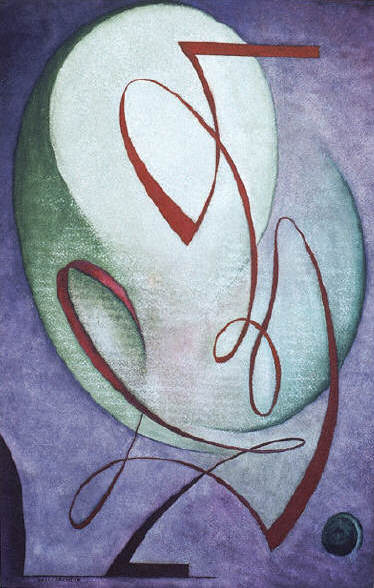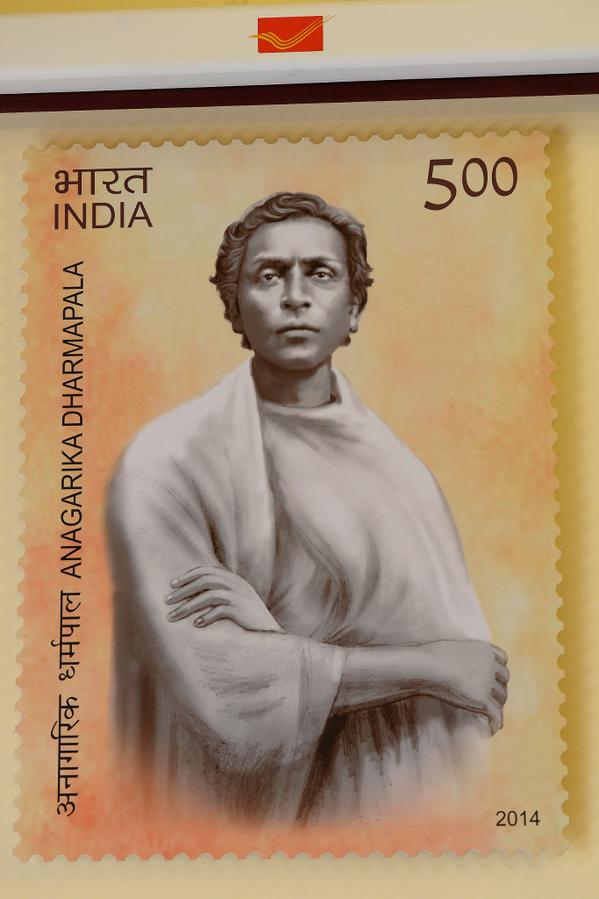Sunday, October 26, 2014
Anagarika Dharmapala
The President of India’s Twitter feed announces the release of a new stamp honouring Sri Lankan Buddhist Anagarika Dharmapala. “The release of the commemorative postage stamp on Anagarika Dharmapala will contribute towards further strengthening the bilateral ties between India and Sri Lanka and bring the two nations closer,” said President Mukherjee.
Reporting on the occasion a number of South Asian news sources mentioned: Along with Henry Steel Olcott and Helena Blavatsky, the creators of the Theosophical Society, he was a major reformer and revivalist of Ceylonese Buddhism and an important figure in its western transmission.
Events celebrating the 150th anniversary of Dharmapala’s birth were held in England and Sri Lanka in September. In London, An Exhibition on the Life and Work of Anagarika Dharmapala, Founder of London Buddhist Vihara, was held from September 14 to 20, 2014. Over the seven days guests included the Mayor of Ealing, the UK Sri Lanka High Commissioner, and the President of the Buddhist Society among others. In Sri Lanka a stamp was also issued commemorating his anniversary.
Previous coverage of Dharmapala (1864-1933) and his connection with Blavatsky can be found here. Steven Kemper’s Rescued from the Nation: Anagarika Dharmapala and the Buddhist World, the first book length study of his career, to be released next month by the University of Chicago Press, will no doubt bring him renewed recognition. According to the publisher’s press release:
Drawing on huge stores of source materials—nearly one hundred diaries and notebooks—Kemper reconfigures Dharmapala as a world-renouncer first and a political activist second. Following Dharmapala on his travels between East Asia, South Asia, Europe, and the United States, he traces his lifelong project of creating a unified Buddhist world, recovering the place of the Buddha’s Enlightenment, and imitating the Buddha’s life course. The result is a needed corrective to Dharmapala’s embattled legacy, one that resituates Sri Lanka’s political awakening within the religious one that was Dharmapala’s life project.
Chapter 1 deals with Dharmapala as a Theosophist.
Thursday, October 23, 2014
Blavatsky and Mexican Politics
A Mexican President may not seem a likely reader of Blavatsky but journalist C.M. Mayo has shown this was the case with Mexico’s 33rd President Francisco Ignacio Madero (1873‒1913):
Francisco Ignacio Madero was the leader of Mexico’s 1910 Revolution and the democratically elected President of Mexico from 1911 until 1913, when, in a violent coup, his government was overthrown and he was murdered. Today Madero is best remembered as the “Apostle of Democracy,” the visionary leader who overthrew Porfirio Díaz, the dictator who had ruled Mexico, both directly and indirectly, for more than three decades.
Less known is that Madero was also one of Mexico’s leading Spiritists and a medium. Not only did he maintain an extensive correspondence with Spiritists in France and Mexico, but he was a organizer of Latin America’s first and second Spiritist Congresses held in Mexico in 1906 and 1908, respectively, and it was after the latter that he took upon himself the task of writing and publishing the ardently evangelical Spiritist Manual, albeit under the pen name, “Bhima.”
In her new book, Metaphysical Odyssey Into the Mexican Revolution: Francisco I. Madero and His Secret Book, Spiritist Manual, Mayo gives a rare glimpse into the esoteric world that flourished in Spain and in Mexico in the early part of the 20th century.
In the late 19th century, though elite Mexicans more often traveled to, studied in and had business dealings in the Unted States, they tended to feel more comfortable with French language and culture. Unsurprisingly then, it was Kardecian Spiritism, rather than American Spiritualism, that first made inroads in Mexico. This was in 1872, thanks to Refugio González's translations of Kardec’s books, among other Spiritist works.
During this same period, the Russian mystic and co-founder of Theosophy, Helena Petrovna Blavatksy (1831-1891) published her seminal works, Isis Unveiled (1878) and the Secret Doctrine (1888), which were almost immediately translated into French and which infused Western esoteric thinking, including that of some of the Spiritists, with new strains of Eastern and neopagan thought.
Mayo’s findings after months spent going through Madero’s library in Mexico City offer an indication of the diffusion of these ideas outside the Anglo-European grid. The latter part of the book contains her English translation of Madero’s 1911 Manual Espírita, his attempt to fuse spiritist and theosophical ideas published under the name Bhima. More information about the book and an interview with the author commenting on the mixing of European esotericism and Mexican beliefs can be found here.
Sunday, October 12, 2014
Collected Writings of Charles Johnston
Charles Johnston (1867-1931) was one of the first western theosophists to start translating Indian scriptures from the Sanskrit. Johnston wrote close to 500 articles during his life, as well as pamphlets, booklets, and eight books. Jon W. Fergus, the compiler, in the biographical sketch that opens Volume 1 of Hidden Wisdom: Collected Writings of Charles Johnston, says “by quantity alone, Mr. Johnston, ranks among the most prolific theosophical writers. In quality he may, perhaps, likewise rank.”
The present work, in four volumes, represents all “theosophical” articles from the pen of Charles Johnston that have been located to date. These are drawn largely from Theosophical periodical magazines between the years of 1886 and 1932. The articles have been arranged by subject matter, and the volumes organized to reflect certain overarching themes.
Volume 1: Wisdom Traditions of East and West, a long section on the Wisdom of India; Volume 2: The Wisdom of India and Western Wisdom; Volume 3: In the Light of Theosophy, which covers articles related to Theosophy and symbolism, consciousness, etc.; Volume 4: Miscellaneous articles, including biographical sketches of Blavatsky and Olcott. Each volume is over 500 pages, some over 700 pages.
Concurrent with it are publication of separate volumes containing his translations on the Bhagavad-Gita, Sankaracharya, the Yoga Sutras of Patanjali, the Upanishads, and the Tao Teh King, all of which can be obtained from Kshetra Books.
Added to his achievements was the fact that he was married to Blavatsky’s niece Vera Vladimirovna de Zhelihovsky.
Thursday, October 9, 2014
Dane Rudhyar and Blavatsky
The Autumn 2014 issue of SPICA, the Postgraduate Journal for Cosmology in Culture from the Sophia Centre for the Study of Cosmology in Culture at the University of Wales, carries “A Critical Biography of Dane Rudhyar” by Sanaa Tanha, which looks at the influences on his multifaceted career as composer, artist, writer, and astrologer:
 |
| Antiphony, Dane Rudhyar, 1949 |
Rudhyar’s career is given in detail at the Rudhyar Archival Project site which lists his books, articles, musical compositions and a catalogue of his art work. For Rudhyar (1895–1985) music was “a direct release of psychic energy whose source is an inner feeling or experience.” Rudhyar’s music was featured recently as part of the “Museum and Music” series at the Nora Eccles Harrison Museum of Art at Utah State University. The program connects with the exhibit on view, “Enchanted Modernities: Mysticism, Landscape and the American West,” which includes paintings done by Rudhyar and other members of the Transcendental Painting Group that flourished in Santa Fe, New Mexico, in the 1930s.
 |
| Dane Rudhyar, 1956 |
Blavatsky in Utah
Utah Public Radio gives a guided tour of the “Enchanted Modernities: Mysticism, Landscape and the American West” exhibit currently at the Nora Eccles Harrison Museum of Art at Utah State University in Logan, Utah. “As we ascend the steps leading to the exhibit, we are first confronted by a large, looming black and white photograph of the Founder of Modern Theosophy, Madame Helena Blavatsky.”
One of the curators of the exhibition tells the reporter: The picture that greets you is one of her in her characteristic pose looking directly into the camera, unflinching. This is often a pose which is taken up by many Theosophists in photographs because they felt that this could show their power. You could see into their eyes and see into their soul. You have to begin with Blavatsky to understand Theosophy in the 19th and 20th century. Everything kind of flows from there. So the exhibition begins with Blavatsky as well.
It goes on from there. The rest of the story can be heard here. The exhibit will be on view until December 2014.
Thursday, October 2, 2014
Blavatsky News
* England’s Independent reviews the recent BBC4 programme The Rules of Abstraction with Matthew Collings:
The artist and critic began his 90-minute programme by tracing the history of abstract art back to its origins in the fascinating 19th-century Theosophy movement of Helena Blavatsky. From here he moved on to the colours and shapes of Kandinsky, Pollock, Rothko and more.
Artists still seem to be relating to Blavatsky. In a recent New York Times interview with conceptual artist Alexander Melamid, to make his point, he found it necessary to say:
Art is not only physical pollution, it’s intellectual pollution. Spiritual pollution. I belong to the down-the-drain generation. We were promised salvation by art. I was a passionate believer, until I realized it was one of those allegiances, like spiritualism or theosophy. All of this kind of semi-religious teaching, like Mary Baker Eddy or Madame Blavatsky.
* Sam Harris's latest book Waking Up continues to garner attention. Perhaps it is the claim of the book's subtitle: A Guide to Spirituality Without Religion. Chapter 1 can be read here. Mentioning Mme. Blavatsky, he says:
The conversation between East and West started in earnest, albeit inauspiciously, with the birth of the Theosophical Society, that golem of spiritual hunger and self-deception brought into this world almost single-handedly by the incomparable Madame Helena Petrovna Blavatsky in 1875. Everything about Blavatsky seemed to defy earthly logic: She was an enormously fat woman who was said to have wandered alone and undetected for seven years in the mountains of Tibet. She was also thought to have survived shipwrecks, gunshot wounds, and sword fights. Despite the imponderables in her philosophy, Blavatsky was among the first people to announce in Western circles that there was such a thing as the "wisdom of the East." This wisdom began to trickle westward once Swami Vivekananda introduced the teachings of Vedanta at the World Parliament of Religions in Chicago in 1893.
* The following passage from W.B. Yeats’s The Trembling of the Veil on his experiences with Madame Blavatsky in London makes its appearance online:
Besides the devotees, who came to listen and to turn every doctrine into a new sanction for the puritanical convictions of their Victorian childhood, cranks came from half Europe and from all America, and they came that they might talk. One American said to me, “She has become the most famous woman in the world by sitting in a big chair and permitting us to talk.” There was a woman who talked perpetually of “the divine spark” within her, until Madame Blavatsky stopped her with—“Yes, my dear, you have a divine spark within you and if you are not very careful you will hear it snore.”
Subscribe to:
Posts (Atom)



